I awoke to the sounds of gunshots because today is the first day of deer firearms season which lasts for two weeks (except Sunday--hurray for the religious). I am afraid to go out in the woods to take photos even with wearing a blaze orange vest and hat. Forget about taking the dog out for a walk as
Kookie only has the blaze orange collar. She looks just like a deer running in the woods.
So instead of walking, I am sitting here at the computer doing this post on a gorgeous sunny warm day.

Yesterday, I noticed my honey bees were out and about bringing in water and pollen. That's not surprising since the weather has been nice and warm (70 degrees most of the week). But where were they getting the pollen? The goldenrod and
wingstem are long past flowering--the same for the asters.

I did notice this solitary dandelion blooming but that was probably not the source.

Then, I spotted the witch-hazel tree that was in full bloom. Sure enough, there were honey bees all over it. The witch-hazel is special that way--always blooming in November, a welcome respite from all the brown.

This close up of the flowers was posted on my blog a couple of years ago with the following text:
The Witch-hazel is an understory tree that is fairly common in our woods and a favorite of the Wood Thrush bird for their nests. The leaves are aromatic and can be used to make astringent lotions. Some old timers use the forked branch of the Witch-hazel branch to detect underground water.

This was an earlier photo of the beehive about a week before. The entrance reducer is pushed out so that the bees were able to come and go as they please. I swear I saw them pushing the entrance reducer out themselves! Anyway, the reducer is used to keep predators out but especially mice which will come in and build a nest making a mess. I made my own from 1 x 1 trim. I put 4 holes in it since I knew they wanted more than the typical small hole.
Thoughts on Hive Winter PreparationThis year I left a lot more honey on the hive, (2-1/2 medium boxes). It seemed I had twice the number of bees going into the winter as last year so it made sense to me. The bottom one had brood and lots of pollen storage. I figure the winter cluster can gradually move up the hive through the honey which also should help insulate against the cold.
I'm keeping my fingers crossed that I won't lose the bees this winter like I did last year. But one thing I noticed about these bees is that they seem a lot healthier than last year's bees. I kept doing varroa mite checks all summer and did not see any until the very last time when I counted about 5 (used powdered sugar treatment to check). Last year, I counted over a hundred on last check. Nevertheless, I plan on leaving the mite board out of the screened bottom board to allow any mites to fall off to the ground and to allow plenty of ventilation. Last year, I got so concerned about the cold that I left the board in. Maybe the mites got to them or the lack of ventilation made them susceptible to nosema (a fungal infection).











